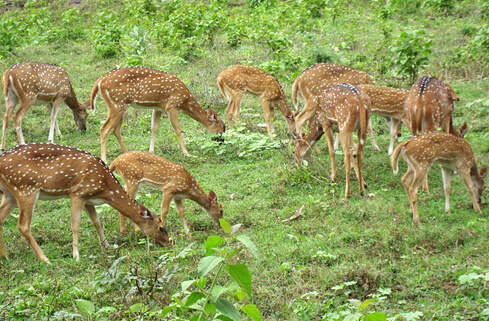Axis Deer on Big Island, Hawaii A New Threat to Native Birds, Agriculture, Natural Resources
MEDIA RELEASE
Contact: Robert Johns, 202-234-7181 ext.210, bjohns@abcbirds.org
 |
| Axis Deer; Wikipedia Commons |
(June 2, 2011) A coalition of resource managers on Hawai‘i Island have confirmed the presence of a new threat to the island's biodiversity – introduced axis deer – in the areas of Kohala, Ka‘u, Kona, and Mauna Kea.
The deer, which can reach up to 250 lbs. were first introduced to Moloka‘i and O‘ahu in 1868, Lana‘i in 1920, and Maui in 1959. Historically, they were not introduced to the island of Hawai‘i, and their confirmed presence on that island has grave implications for the island's farmers and ranchers, public health, watersheds, and native ecosystems and species. Axis deer have caused extensive problems on Maui where more than 12,000 roam, wandering onto ranch land and farmland, and into urban areas resulting in millions of dollars in damages to crops, trees and bird habitat.
A joint effort is now underway between the Hawaiian Department of Land and Natural Resources' Division of Forestry and Wildlife (DOFAW), the U.S. Department of Agriculture, Big Island Invasive Species Committee (BIISC), federal natural resource management agencies, ranchers, farmers, private landowners, and concerned citizens to develop and implement a strong, swift action to protect the island. BIISC is working with trackers and using game cameras to survey and confirm locations of these animals across the island and to ultimately remove them.
Conservation agencies are particularly concerned about the impact to native ecosystems and the numerous threatened and endangered species they contain. If deer become established, existing conservation exclosure fences on the island will have to be raised to eight feet.
George Wallace, American Bird Conservancy's Vice President for Oceans and Islands states, “I hope that this problem can be solved before we have to retrofit more than 300 miles of fences as that will cost tens of millions of dollars and jeopardize years of work to rid ungulates from several areas of critical importance for birds.
For example, the Hakalau Forest National Wildlife Refuge, a key area for the endangered Akiapōlā'au, Ākepa, and Hawai‘i Creeper, has been largely cleared of feral pigs, making large-scale reforestation possible. Hawai‘i Volcanoes National Park was a national leader in using fences to remove goats to protect their endangered plants and animals. DOFAW is currently constructing a fence around Palila Critical Habitat on Mauna Kea with the objective of eradicating mouflon-sheep hybrids that severely damage the māmane forests on which Palila depend. In all these cases, the establishment of axis deer will have a substantial negative impact on conservation efforts.
“These new deer on the Big Island are apparently the result of a deliberate inter-island introduction. We need to do a better job of public education about the impacts of alien species, especially to Hawai‘i's native birds and plants. Removing introduced species can be both terribly costly and very inefficient,” said Wallace.


















































